German Comics
On the move into the women’s and digital age
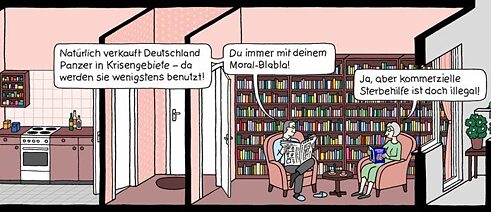
German comics enjoy success with both critics and readers. In vogue are especially subjects pertaining to contemporary history, new forms of narrative and comics produced by women artists.
The year 2016 will someday probably be assigned particular importance in the annals of German comics. That year several extraordinary things happened at the awards ceremony for the prestigious Max and Moritz Prize during the International Comics Salon in Erlangen. The list of 24 nominated titles already announced a turning-point. For the previous three decades mainly imported comic books from the United States and the French-speaking world had been the candidates for the prize; in 2016 the majority of nominated comics were for the first time German productions. With this development, the rating of Germany as a “comics developing country”, which the local scene likes to cultivate, has definitely had its day.
Comics are a women’s business
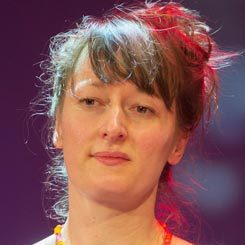 Barbara Yelin became “best German-language comics artist 2016”
| Photo (detail): © Internationaler Comic-Salon Erlangen/Erich Malter
At least as striking is that nearly a third of all titles on the nomination list included women artists. This too is a record, which a few years ago would have seemed inconceivable. In all the categories in which German artists prevailed the awards again went, with only a few exceptions, to women artists. A woman was honoured for the third consecutive time as “best German-language comics artist”. And after Isabel Kreitz und Ulli Lust won the coveted Comics Prize in 2012 and 2014, this year it went to Barbara Yelin.
Barbara Yelin became “best German-language comics artist 2016”
| Photo (detail): © Internationaler Comic-Salon Erlangen/Erich Malter
At least as striking is that nearly a third of all titles on the nomination list included women artists. This too is a record, which a few years ago would have seemed inconceivable. In all the categories in which German artists prevailed the awards again went, with only a few exceptions, to women artists. A woman was honoured for the third consecutive time as “best German-language comics artist”. And after Isabel Kreitz und Ulli Lust won the coveted Comics Prize in 2012 and 2014, this year it went to Barbara Yelin.The Munich-born artist impressed comics readers most recently with Irmina, a story of missed opportunities during the Nazi period. It was inspired by the experiences of Yelsin’s grandmother. Irmina is no great heroine, but rather finally comes to terms with life under the Nazis, thereby acting quite (terribly) normally.
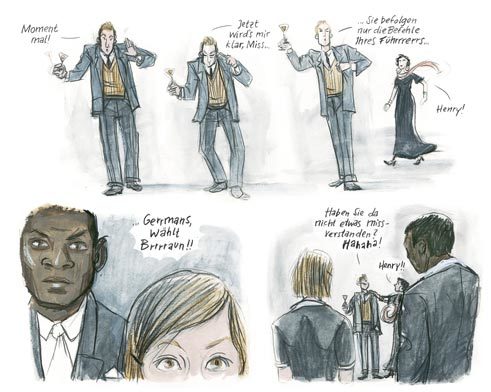 “Irmina” by Barbara Yelin is a story of missed opportunities during the Nazi period
| Illustration (detail): © Barbara Yelin/Reprodukt
“Irmina” by Barbara Yelin is a story of missed opportunities during the Nazi period
| Illustration (detail): © Barbara Yelin/Reprodukt
Contemporary history dominates
Irmina was received enthusiastically by the critics, and proved to be a best-seller amongst the reading public. The graphic novel is thus exemplary of a new set of comic books about events of twentieth century German history. In Kinderland (i.e. Children’s Country), for example, the Berlin artist Mawil describes his daily life as a child in East Germany. It conveys to the reader a powerful feeling of conditions in the year before the Berlin Wall fell.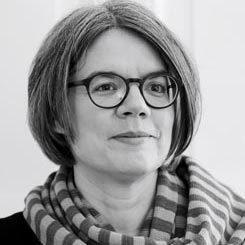 Artist Birgit Weyhe grew up in Africa
| Photo (deail): © Avant-Verlag
Even less known history of the East German Communist era comes to light in Birgit Weyhe’s Madgermanes. “Madgermanes” was the name given workers recruited from Mozambique, who came to the GDR in the 1970s but were not allowed to stay after 1990 in re-unified Germany. Back in Africa, many hundreds of thousands of these people felt cheated of their future and a large part of their wages, which had been deducted during their time in East Germany. An injustice, to which now the artist who grew up in Africa is drawing attention.
Artist Birgit Weyhe grew up in Africa
| Photo (deail): © Avant-Verlag
Even less known history of the East German Communist era comes to light in Birgit Weyhe’s Madgermanes. “Madgermanes” was the name given workers recruited from Mozambique, who came to the GDR in the 1970s but were not allowed to stay after 1990 in re-unified Germany. Back in Africa, many hundreds of thousands of these people felt cheated of their future and a large part of their wages, which had been deducted during their time in East Germany. An injustice, to which now the artist who grew up in Africa is drawing attention.
Publish online
For Madgermanes Weyhe received the 2016 Max and Moritz Prize in the category of “Best German-Language Comic”. Katharina Greve was given the award for “Best Comic Strip”. Traditionally, this category was confined to newspaper comics. But in 2016 the jury extended it to include online publications. Many works published online are similar in form and content to the classical comic strip. On the Internet, too, many comics are published in short episodes.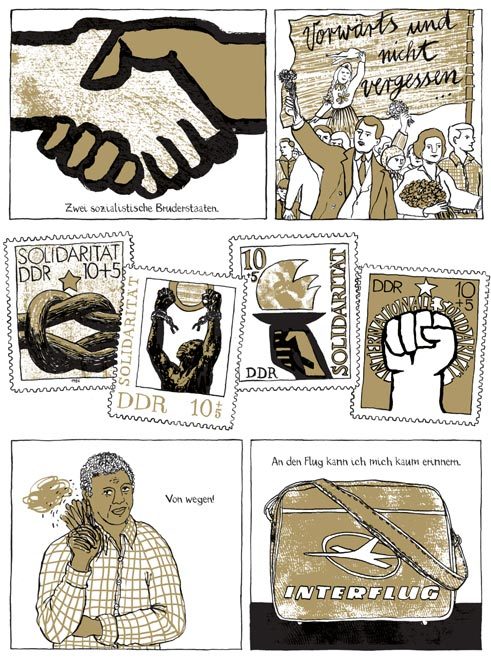 For “Madgermanes” Birgit Weyhe received the 2016 Max and Moritz Prize in the category of “Best German-Language Comic
| Illustration: © Birgit Weyhe/Avant-Verlag
For “Madgermanes” Birgit Weyhe received the 2016 Max and Moritz Prize in the category of “Best German-Language Comic
| Illustration: © Birgit Weyhe/Avant-Verlag
This is exactly what Katharina Greve does: her weekly uploaded “strips” are “floors” with which she then builds an entire house. Her Web comic is therefore entitled Das Hochhaus – 102 Etagen Leben (i.e. The Highrise – 102 Floors of Life). The episodic approach allows her both to project a vast story arc and to respond to very current social developments such as the immigrant crisis. In 2017, Greve has announced, the highrise should be completed.
Advance presentation on the Internet
Dissemination of their work in the Internet is an opportunity for unknown comic artists to introduce themselves to a wider public. For example, the Saarland artist Erik launched deae ex machina on the Web, where he brought mystical elements into confrontation with the technical and social upheavals of the first half of the twentieth century. It was only after publication on the Internet aroused attention that the formally classical series was then published in a print magazine and as album series by a publishing house. Graphic novels that were later to be successful in bookshops, such as Heute ist der letzte Tag vom Rest deines Lebens (i.e. Today Is the Last Day of the Rest of Your Life) by Ulli Lust and Fahrradmod (i.e. Bike Mod) by Tobi Dahmen, were also first published on the Internet. To find a publisher in advance for such works, which comprise hundreds of pages, is difficult; the final release takes several years. An advance presentation on the Internet during the long period of completion allows a first response from the reading public.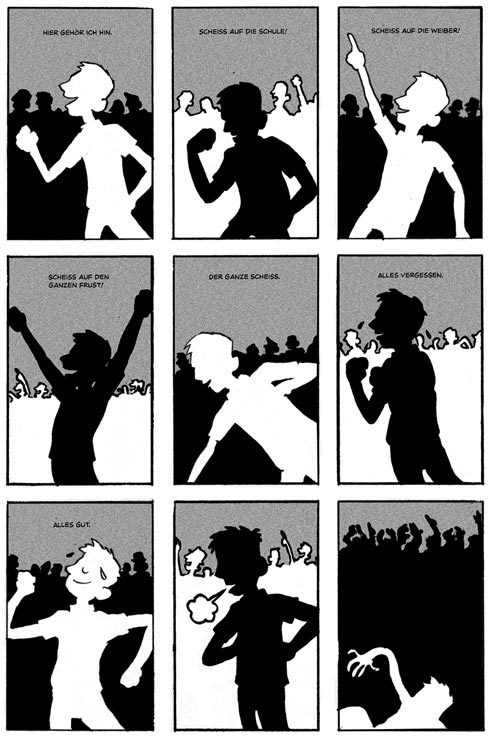 „Fahrradmod“ by Tobi Dahmen was first published on the Internet
| Illustration: © Tobi Dahmen/Carlsen-Verlag
„Fahrradmod“ by Tobi Dahmen was first published on the Internet
| Illustration: © Tobi Dahmen/Carlsen-Verlag
Experimental narrative techniques
The digital world also makes possible new narrative techniques. This is impressively shown by Wormworld Saga by Daniel Lieske. The digital comic makes use of the “infinite screen”; instead of clicking from page to page, the reader scrolls through the story. Union der Helden (i.e. Union of Heroes) by Arne Schulenberg is a photo comic about super heroes from Germany – spiced up with a series of flash animations. And in Zuhause während der digitalen Revolution (i.e. At Home during the Digital Revolution) what stands out is that the artist Digirev, alias Wolfgang Buechs, arranges his online strip in such a way that it can be read frame by frame, yet “Next” arrows always allow the reader to break out of linear reading and simply take a different turn.How permanent these developments will prove is still to be seen. But that German comics will be increasingly dominated by women and the digital world is likely to be an irreversible trend. This will lead to far-reaching changes in the otherwise still very male and analogue German comics scene. Even if the sales share of digital comics has stagnated in the low single digits, it is significant that nearly a quarter of the nominated comics at the 2016 Max and Moritz Prize was originally published on the Internet. As a field for artistic experimentation, the Web has proven to be a godsend for German-language comics.